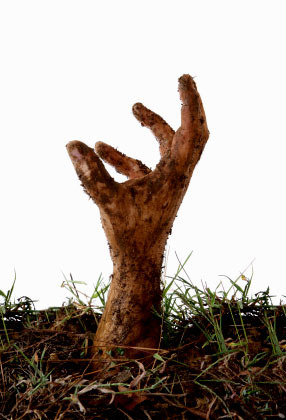
Voodoo’s incursion of U.S. borders recently took an interesting turn when activists protesting against economic disparity in the United States installed themselves at Zuccotti Park in Lower Manhattan. Protests against America’s financial sector that began with just a handful of demonstrators in mid-September have spread across the nation and indeed the world, making the “Occupy” movement one of the most visible and expansive populist movements in recent American history. The New York Times describes these protesters as “a diffuse group of activists who say they stand against corporate greed, social inequality and the corrosive power of major banks and multinational corporations over the democratic process”
An interesting feature of the Occupy Wall Street protests has been the movement’s adoption of zombies as a symbolic representation of the corporate greed against which the occupiers stands. In a march through Manhattan’s financial district early in October, protestors donned zombie costumes to depict themselves as the Wall Street robber barons whose unquenchable appetite for wealth and the bizarre financial instruments spawned as a result contributed to the recent financial meltdown in the American economy. With faces whitened to look lifeless and blood stains painted around their mouths, activists lumbered through Manhattan’s financial district with fake money stuffed in their mouths to portray the ravenous, monstrous, and even cannibalistic greed propelling America’s financial bandits.
What some people may not know is that these monsters are deeply rooted in the Caribbean’s history. Zombies have historically been associated with the Haitian practice of Voodoo (or Vodun), products of the work of a bokor (a magician) who maintains control of the zombie, which is trapped in limbo between life and death. In his book The Serpent and the Rainbow, later made into a movie, Harvard ethnobotanist Wade Davis claims that zombification of a living person is indeed medically possible through the use of tetrodotoxin, a chemical derived from the pufferfish (also known as a balloonfish).
The term zombie was quite likely introduced into the American lexicon by William Seabrook in his 1929 novel set in Haiti titled Magic Island. Seabrook’s book later became the inspiration for the 1932 film White Zombie and influenced a proliferation of early zombie movies. In the 1960’s George Romero’s cult classic, Night of the Living Dead reawakened America’s fascination with these creatures closely tied to the Caribbean, and zombies are now one of America’s favorite monsters.
It is significant and in some ways ironic that zombies should become the icon for an “occupation” force given Haiti’s troubled history with America and Haiti’s own occupation by American military forces from 1915 to 1934. Born from of the 1791 slave rebellion led by Toussaint Louverture in France’s Caribbean colony of Saint Domingue, Haiti became the first black republic in the New World in 1804. The United States’ relationship with Haiti was troubled from the country’s establishment, unsteadied by American anxiety about the emergence of a free black republic in such close proximity. As a result, the United States refused to recognize Haiti until 1862, more than half century after that nation’s independence.
The occupation was ostensibly based on American anxieties over Haiti’s political and economic stability, but some scholars argue that the primary reasons had to do with military strategic concerns. In the book Haiti and the United States, author J. Michael Dash, explains that during the time of the occupation, much of the American discourse about Haiti sought to associate it with the “outlandish,” suggesting that the first free black republic in the West was entrenched in magic, strange, and unstable. Dash further argues that this characterization of Haiti as bizarre and different guaranteed a basis for its economic exploitation for American benefit.
How ironic, then, that almost 100 years after Haiti’s occupation by America, the “monstrous” figures most closely associated with that island should transgress national borders and find their way to New York to initiate a reprisal of sorts and Haiti’s own occupation of America. In fact, this occupation extends far beyond Wall Street to American popular culture and commenced well before the start of the Occupy movement. Television series like The Walking Dead, video games such as Resident Evil series, and movies like I am Legend are all informed by the myth of the zombie. Expectations are that this year’s Halloween will feature an abundance of zombie costumes, now that the figure of the zombie seems to be trendier than ever. The zombie’s current popularity has created a strange symbolic reversal of fortunes: Haiti’s occupation of its previous occupiers’ territory.
About the Author:
Andrea Shaw, Ph.D., is assistant director of the Division of Humanities and an assistant professor of English at Nova Southeastern University in Ft. Lauderdale. She was born in Jamaica and is a creative writer and a scholar of Caribbean and African Diaspora studies. Her book, The Embodiment of Disobedience: Fat Black Women’s Unruly Political Bodies, was published in 2006. Her creative and scholarly writing have been published in numerous journals, including World Literature Today, MaComére, The Caribbean Writer, Crab Orchard Review, Feminist Media Studies, Social Semiotics, and FEMSPEC. She graduated from the University of Miami with a Ph.D. in English and from Florida International University with an M.F.A in Creative Writing.








